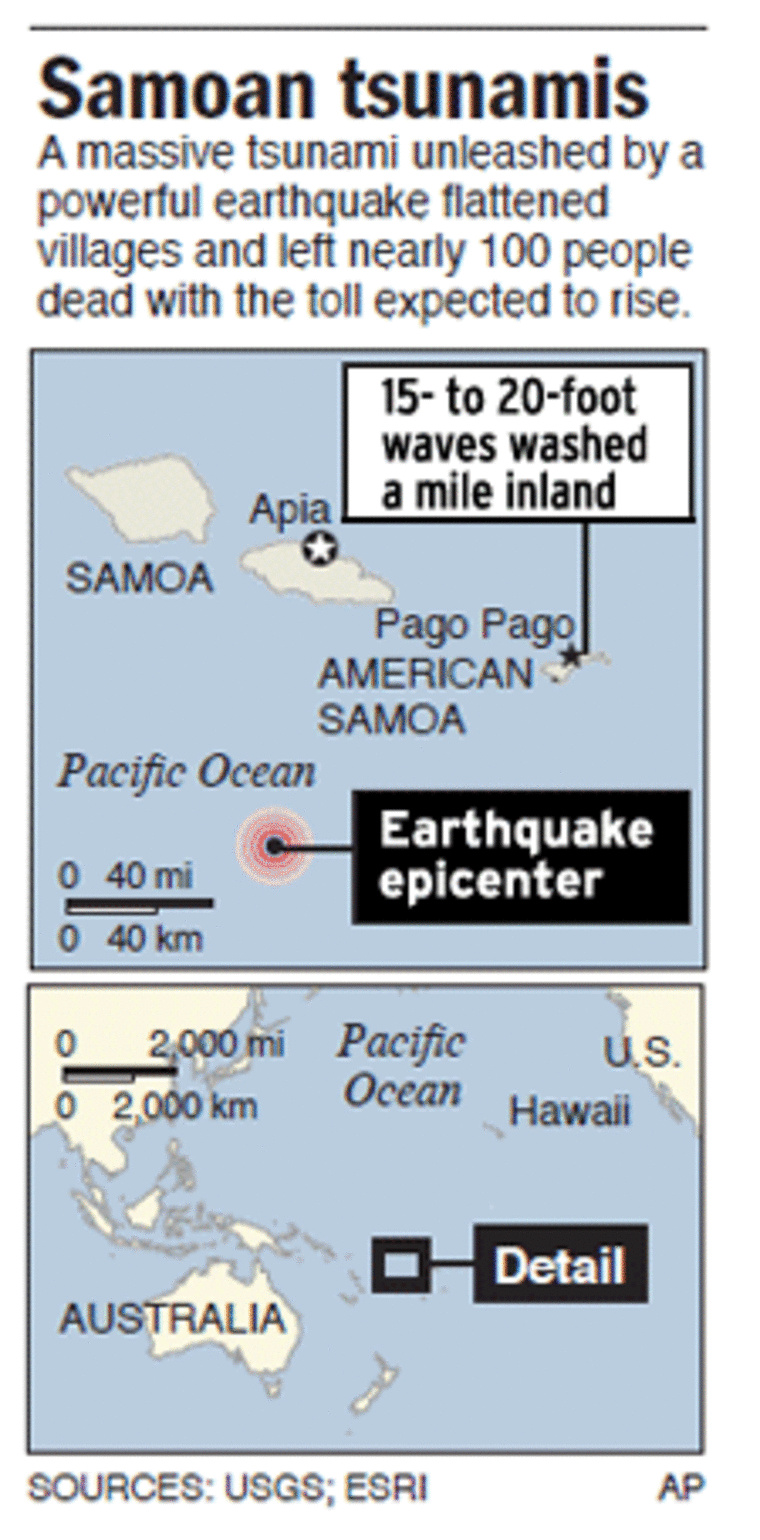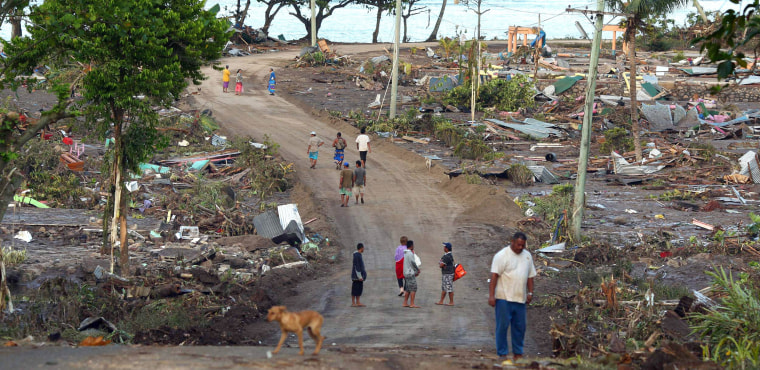Police in green reflective vests searched a ghastly landscape of mud-strewn streets, pulverized homes and bodies scattered in a swamp Wednesday as dazed survivors emerged from the muck and mire of an earthquake and tsunami that killed at least 119 in the South Pacific.
Military transports flew medical personnel, food, water and medicine to Samoa and American Samoa, both devastated by a tsunami triggered by an undersea earthquake. A cargo plane from New Zealand brought in a temporary morgue and a body identification team.
Officials expect the death toll to rise as more areas are searched.
Survivors fled to higher ground on the islands after the magnitude 8.0 quake struck at 6:48 a.m. local time (1:48 p.m. EDT; 1748 GMT) Tuesday. The residents then were engulfed by four tsunami waves 15 to 20 feet high that reached up to a mile inland.
The waves splintered houses and left cars and boats — many battered and upside down — scattered about the coastline. Debris as small as a spoon and as large as a piece of masonry weighing several tons were strewn in the mud.
‘I was scared’
Survivors told harrowing tales of encountering the deadly tsunami.
"I was scared. I was shocked," said Didi Afuafi, 28, who was on a bus when the giant waves came ashore on American Samoa. "All the people on the bus were screaming, crying and trying to call their homes. We couldn't get on cell phones. The phones just died on us. It was just crazy."
With the water approaching fast, the bus driver sped to the top of a nearby mountain, where 300 to 500 people were gathered, including patients evacuated from the main hospital. Among them were newborns with IVs, crying children and frightened elderly people.
A family atop the mountain provided food and water, while clergymen led prayers. Afuafi said people are still on edge and feared another quake.
"This is going to be talked about for generations," said Afuafi, who lives just outside the village of Leone, one of the hardest hit areas.
On Samoa, the two-hour drive from the Apia airport to the heavily damaged southeast coast initially showed no sign of damage before becoming little more than a link between one flattened village after another. Mattresses hung from trees, and utility poles were bent at awkward angles.
It was clear that tourists were among the casualties, but figures were impossible to ascertain immediately with officials saying they had no solid head count on the number of visitors in the area.
"There's not a single house up, it's total devastation (in) the most popular place for tourists," Dr. Ben Makalavea from Apia's main hospital told New Zealand's National Radio Thursday. He said some couples can't find their children, and fear they may have been washed out to sea.
"One woman we saw was so confused that she doesn't even know where she comes from," he said.
Shortage of medical personnel
Makalavea added that the hospital needs nurses, doctors, surgeons and blood to treat the increasing numbers of casualties with broken bones and cuts.
At Sale Ataga village, more than 50 police, some wearing masks to filter out some of the growing stench of decay in the steamy conditions, searched for bodies underneath uprooted trees and palms piled up at the foot of a mountain.
Tony Fauena, a 29-year-old taro farmer, said the bodies of his 35-year-old niece and her 6-month-old son were found Tuesday but four other family members were still missing. "We don't know if the rest are under there or released out to sea," he said.
Suavai Ioane was rattled by the violent earthquake that shook Voutosi, a village of 600 people. But he didn't have much time to calm down.
"After the shaking finished, about five or 10 minutes after, the wave very quickly came over us," said Ioane, who was carried by a wave about 80 yards (meters) inland. He knew he was lucky to be alive; eight bodies were found in a nearby swamp.
The Pacific Tsunami Warning Center in Hawaii said it issued an alert, but the waves got to the islands so quickly that residents only had about 10 minutes to respond. Another system designed to alert aid agencies suffered a hardware malfunction that delayed notification, but that did not affect island residents.
The quake was centered about 120 miles south of the islands of Samoa, which has about 220,000 people, and American Samoa, a U.S. territory of 65,000.
Another quake rocks Indonesia

Another strong underwater earthquake rocked western Indonesia Wednesday, briefly triggering a tsunami alert along the Indian Ocean. The 7.6-magnitude quake toppled buildings, cut power and triggered a landslide on Sumatra island, and at least 75 people were reported killed. Experts said the seismic events were not related.
Hampered by power and communications outages, officials in the South Pacific islands struggled to determine casualties and damage.
Samoa National Disaster Management committee member Filomina Nelson told New Zealand's National Radio the number of dead in her country had reached 83 — mostly elderly and young children. At least 30 people were killed on American Samoa, Gov. Togiola Tulafono said.
Authorities in Tonga, southwest of the Samoas, confirmed at least six dead and four missing, according to Tongan government spokesman Lopeti Senituli. He said the waves practically flattened two of the island's three villages. The government dispatched a boat with supplies to the island to help its more than 1,000 residents.
In Pago Pago, the streets and fields were filled with debris, mud, overturned cars and boats. Several buildings in the city — just a few feet above sea level — were flattened. Power was expected to be out in some areas for up to a month and officials said some 2,200 people were in seven shelters across the island.
"Right now, we're focused on bringing in the assistance for people that have been injured, and for the immediate needs of the tens of thousands of survivors down there," said FEMA Administrator Craig Fugate.
Reinforcements were on the way, including a Navy frigate and two huge Air Force cargo planes soon to leave from Hawaii.
Obama declares major disaster
A Coast Guard C-130 plane loaded with aid and carrying Federal Emergency Management Agency officials flew from Hawaii to American Samoa's capital of Pago Pago, where debris had been cleared from runways so emergency planes could land. President Barack Obama declared a major disaster for American Samoa.
English said the temporary morgue and the body identification team were sent to Samoa after local officials expressed concern "about the growing death toll."
Hundreds of people bombarded American Samoa's radio stations with requests to announce the names of their missing loved ones. Broadcasters urged listeners to contact their families immediately.
In Carson, Calif., High Chief Loa Pele Faletogo, president of the Samoan Federation of America, comforted Samoans in the U.S. who came to him seeking news of their relatives. The chief said he learned the body of one of his cousins, in her 60s, was found floating along the shore.
All 65 employees at the National Park of American Samoa were accounted for, said Holly Bundock, spokeswoman for the National Park Service's Pacific West Region in Oakland, Calif. The park service has 13 permanent workers and between 30 and 50 volunteers, depending on the time of year.
The Australian Department of Foreign Affairs said three Australians were among the dead. The British Foreign Office said one Briton was missing and presumed dead.
While the earthquake and tsunami were big, they were not on the same scale of the 2004 Indian Ocean tsunami that killed more than 230,000 in a dozen countries across Asia.
More on: Samoa | American Samoa | Earthquakes
